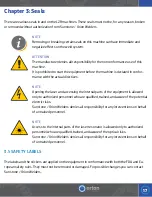
13
NOTE
The laser generated here is a class IV. The risks associated with class IV lasers
include not only the risk of direct or reflected radiation, but also of diffused radia-
tion. These lasers can present a remarkable risk for the skin and eyes, as well as a
fire risk when working near flammable materials
2.1: LASER RADIATION ABSORPTION
The human tissue absorbs electromagnetic radiation in different ways, depending on the wavelength
of the radiation. Eyes and skin accept some wavelengths, while refracting others. Specifically relat-
ing to the eye, the cornea and the lens both allow lasers within the 400-1400nm wavelengths to pass
through and reach the retina. The wavelength of the LZR machines is 1064nm, and therefore it will
pass through unobstructed to the retina.
In regards to skin, the absorption of the radiation will vary from one person to the next, regardless of
the wavelength. Therefore, seeing as the absorption may vary, the exact and specific details are hard
to state regarding the maximum tolerable exposure levels.
Picture 1: Eyeball
The extent of damages due to radiation absorption depends on the wavelength. The short wave-
lengths (ultraviolet UV-C 180-280nm, UV-B 180-280nm, UV-A 315-400nm) generally provoke and
cause photochemistry effects: cataract or opacification of the lens in the eye, blackening or reddening
for the skin. Major wavelengths (infrared: IR-a 780-1400nm IR-c 3000-10 E6nm) generally provoke
thermal effects: retinal detachment and photocoagulation for the eye, burning for the skin.
Summary of Contents for Combo 200
Page 1: ...Orion Laser Welder User Manual Orion Combo 200 ...
Page 4: ...4 ...
Page 7: ...7 ...
Page 52: ...52 ...














































